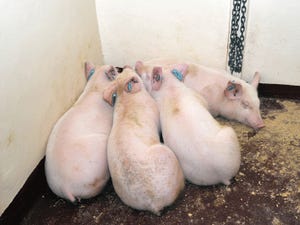New insurance policy aims to provide relief in expenses if ASF hits
Previously the policy was called the business disruption or market value policy and would indemnify based on the value per hundredweight.

For pork producers concerned about insuring their business if African swine fever or foot and mouth disease should even cross the United States border, James Allen Insurance has a new policy designed to do just that.
“With the expense reimbursement model, it will pay just if African swine fever enters the country,” says Chris Moore, who represents James Allen Insurance and ONI Risk Partners. “If it’s found in a wild boar in southwest Texas and I have a sow farm in Minnesota, I can have certain expenses -- some of my fixed costs that I have -- the insurance policy can reimburse me for those fixed costs.”
Previously the policy was called the business disruption or market value policy and would indemnify based on the value per hundredweight; however, Moore says there were not many insurance and reinsurance companies that understood the dip in the hundredweight production or the hundredweight value. They did understand the expense reimbursement model.
While hog producers with finishing units would rather utilize their risk management through hedging and options, the expense reimbursement policy has garnered interest from producers raising weaned pigs, genetic multipliers and boar studs.
“They are more limited in what they can do from a risk management standpoint in terms of options and what they can do on the Chicago Mercantile Exchange, so those people buy this option a lot,” Moore says.
In the event either ASF or FMD were to enter the United States, a claim would be triggered with this policy. Once a claim is triggered, the insured will suffer the first two months of the indemnity period with no expenses reimbursed. After that, the insurance policy will reimburse the producer those expenses incurred or the monthly allocation for those expenses.
Moore gives the example of a 3,000-sow farrow-to-wean operation, with $208,000 in monthly expenses. The expenses are then divided by categories, such as feed costs, medication, payroll, waste removal services, etc. The policy would provide a gross annual coverage limit of $2,496,000 and a net annual coverage of $2,080,000. The difference between the gross and the net is two months.
“The goal behind this product is to provide a hog producer relief in expenses during a catastrophic event for the pork industry,” Moore says. “Our hope is that in the event there were to be an ASF outbreak, producers that buy this insurance will be able to maintain their equity in their operations.”
The new expense reimbursement policy was announced two weeks ago, and JAI has been busy writing the first round of policies that will go into effect April 1. Thus far 10 farms, representing 50,000 sows have signed up for the new insurance program.
For producers more worried about the direct impact an outbreak on their farm or in their region would have on their business, JAI also still has a mortality policy for ASF and FMD. The policy can be purchased as a stand-alone or can be wrapped into an overall farm mortality policy, however the producer gets to decide the value they want per animal, rather than just current market value.
“Not only are we able to give them insurance on the actual sow value from a market perspective, but we are also allowed to put in the business income component,” Moore says. “We are able to give them insurance for the lack of that production value that sow would ultimately have over a lifetime, rather than what she is worth on the market today.”
The mortality policy will pay out if that farm breaks with ASF or FMD, if the farm is in an area the government deems as a mandatory slaughter zone, and if the producer needs to transport pigs across regional or state lines and there’s a stop movement in place.
Moore says the policies basically address two segments within the industry.
“If someone is worried about the impact of ASF and not necessarily worried about it coming close to the farm, but worried about if it came into the country, they are more apt to buy the expense reimbursement model,” Moore says. “If the school of thought is I am worried about ASF coming into my farm or due to large stop movement issue, I’m worried about the availability to move pigs, they will buy the mortality policy. Some people buy both.”
About the Author(s)
You May Also Like





